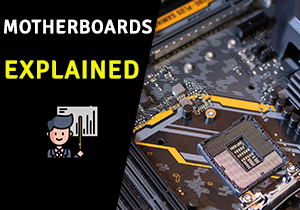Hello and welcoming you for another interesting article. In here we are going to discuss about The Motherboard and what does this magnificent piece of circuit board do.
Brief Intro about the Motherboard
Motherboard is the main component of any computer. Not only
the computers, but most of the electrical devices are also equipped with a Motherboard
such as Mobile phones, Control panels, Remotes, ACs, and even the calculators.
Today we are going to mainly discuss about the Computer Motherboard or Computer
Mainboard. As I said before it is a large circuit board that fits in to the
computer case and all the supporting components are connected to the
motherboard.
Components of a Computer Motherboard
There are
several sockets on the Motherboard which play a huge roll. So, for an example
there's the CPU socket. The CPU socket is where the CPU also known as the Central
Processing Unit is placed. on a consumer grade Computer Motherboard there is
only one CPU socket is available but large machines and control panel
motherboards may have equipped with several CPU sockets.
And next the memory slots. This is where the primary memory also known as RAM (Random Access Memory) are inserted, and according to the type of the motherboard the available slots can be vary. There are also Expansion slots, which are used to install various components to enhance a computer's capabilities, such as a video card, sound card, network card, and so on. And Next, the SATA connectors, and this is where you would attach your storage devices, such as SSDs or Hard Drives.
Motherboards have several of these connectors (ports) so you can attach multiple storage drives. And some modern motherboards you might find the M.2 slot. And this is a newer slot for attaching an M.2 solid-state drive. You can get a broader idea about these SSDs by reading my article about it. Read Here 👉 What is SATA SSD M2 and NVMe
Chipset to PCH Transition of Motherboards
On modern motherboards, you'll also find the PCH (Platform Controller Hub). This hub is Intel's latest chipset architecture, which has replaced the older architecture in which motherboards were made up of a couple of chips called a Chipset. You might have heard this word.
But now this
architecture has been replaced by the Platform Controller Hub chip. (PCH). In
the PCH architecture, the functions of the Northbridge have been largely
integrated into the CPU.
That means
most of all work done by the CPU which Northbridge Chipset has done in the
past. So now the Northbridge chip has been completely eliminated. And the functions of the Southbridge are now
entirely handled by the PCH chip.
Ports of the Motherboard
So, when it comes to Ports of motherboards (Input/output Interfaces) the most common interface on a motherboard is a USB port. For your information the USB stands for Universal Serial Bus and motherboards will typically have Several USB ports because there are so many different devices that utilize the USB interface. Such as Basic Input devices (Keyboard, Mouse), USB Drives Printers, Camera etc.
And those majority of USB ports are mounted in the rear Input/output panel. When it comes to Display Outputs older motherboards will have either a DVI or VGA port, while modern motherboards will have an HDMI port or a DisplayPort.
And another most important Input area is PCI-E Slot of a Motherboard. Since Integrated Graphics are not powerful for extensive graphics, we have to use External Graphic card. Upper series motherboards come with several PCI-E slots by giving the opportunity to install multiple graphics cards and accumulate their power at once. Scalable Link Interface (SLI) which is a brand name for a multi-gpu technology developed by Nvidia for linking several cards together.
And some other things that would appear on a rear input/output panel is the Network Interface port and Sound outputs. And this Network interface port is designed for an RJ-45 connector with an Ethernet cable to connect the computer to a network.
Form factors of Consumer Grade Motherboards
And today consumer motherboards come in different shapes and sizes. And this is known as a Form factor. And the most common consumer motherboard form factor that's used in PCs today is ATX. ATX stands for Advanced Technology Extended. It was created in 1995. If you are interested of the history of ATX and before the ATX which was AT Form factor, please do small research on google and you will have a proper idea about it.
 |
| Three Main Motherboard Form factors |
A full-size ATX motherboard is 12 x 9.6 inches. ATX motherboard has more features compared to other types of motherboards such as more Expansion slots, Ports and etc. Another version of the ATX motherboard is the micro ATX. This Micro ATX motherboards are smaller than ATX boards, you can see that even from its name. Micro ATX boards are 9.6 x 9.6 inches. So, it's a square design compared to the standard ATX Motherboard. These Micro ATX boards are cheaper than ATX boards and were designed to fit in smaller computer cases and they also have fewer features and consume less power than a standard ATX board.
And there is a form factor called Mini-ITX(Information Technology Extended). It is a small motherboard form factor developed by VIA Technologies, which was first introduced in November 2001 with the Mini-ITX platform. Furthermore, due to limited physical space, M-ITX boards typically have fewer VRMs than full-size ATX boards. This limits the chips' overclocking capability because power delivery is compromised in comparison to a larger board. So that’s all for this article and hope to discuss more specific areas on the motherboard in future.





0 Comments